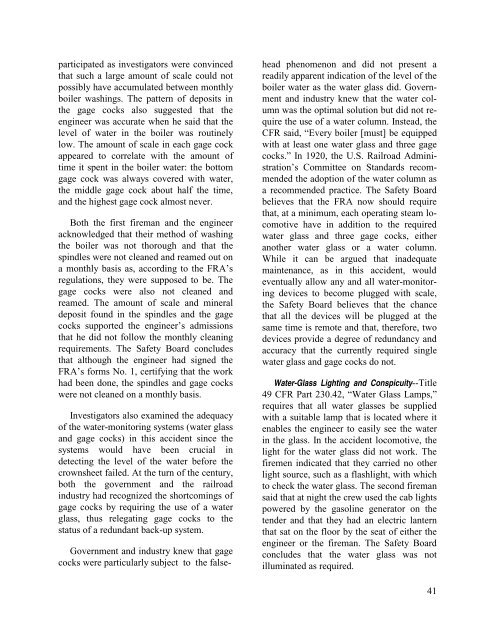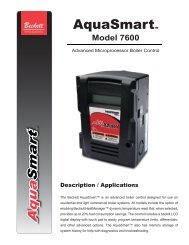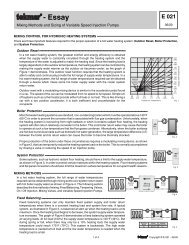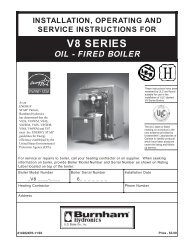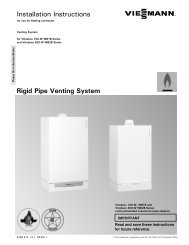Steam Locomotive Firebox Explosion on the Gettysburg Railroad ...
Steam Locomotive Firebox Explosion on the Gettysburg Railroad ...
Steam Locomotive Firebox Explosion on the Gettysburg Railroad ...
You also want an ePaper? Increase the reach of your titles
YUMPU automatically turns print PDFs into web optimized ePapers that Google loves.
participated as investigators were c<strong>on</strong>vinced<br />
that such a large amount of scale could not<br />
possibly have accumulated between m<strong>on</strong>thly<br />
boiler washings. The pattern of deposits in<br />
<strong>the</strong> gage cocks also suggested that <strong>the</strong><br />
engineer was accurate when he said that <strong>the</strong><br />
level of water in <strong>the</strong> boiler was routinely<br />
low. The amount of scale in each gage cock<br />
appeared to correlate with <strong>the</strong> amount of<br />
time it spent in <strong>the</strong> boiler water: <strong>the</strong> bottom<br />
gage cock was always covered with water,<br />
<strong>the</strong> middle gage cock about half <strong>the</strong> time,<br />
and <strong>the</strong> highest gage cock almost never.<br />
Both <strong>the</strong> first fireman and <strong>the</strong> engineer<br />
acknowledged that <strong>the</strong>ir method of washing<br />
<strong>the</strong> boiler was not thorough and that <strong>the</strong><br />
spindles were not cleaned and reamed out <strong>on</strong><br />
a m<strong>on</strong>thly basis as, according to <strong>the</strong> FRA’s<br />
regulati<strong>on</strong>s, <strong>the</strong>y were supposed to be. The<br />
gage cocks were also not cleaned and<br />
reamed. The amount of scale and mineral<br />
deposit found in <strong>the</strong> spindles and <strong>the</strong> gage<br />
cocks supported <strong>the</strong> engineer’s admissi<strong>on</strong>s<br />
that he did not follow <strong>the</strong> m<strong>on</strong>thly cleaning<br />
requirements. The Safety Board c<strong>on</strong>cludes<br />
that although <strong>the</strong> engineer had signed <strong>the</strong><br />
FRA’s forms No. 1, certifying that <strong>the</strong> work<br />
had been d<strong>on</strong>e, <strong>the</strong> spindles and gage cocks<br />
were not cleaned <strong>on</strong> a m<strong>on</strong>thly basis.<br />
Investigators also examined <strong>the</strong> adequacy<br />
of <strong>the</strong> water-m<strong>on</strong>itoring systems (water glass<br />
and gage cocks) in this accident since <strong>the</strong><br />
systems would have been crucial in<br />
detecting <strong>the</strong> level of <strong>the</strong> water before <strong>the</strong><br />
crownsheet failed. At <strong>the</strong> turn of <strong>the</strong> century,<br />
both <strong>the</strong> government and <strong>the</strong> railroad<br />
industry had recognized <strong>the</strong> shortcomings of<br />
gage cocks by requiring <strong>the</strong> use of a water<br />
glass, thus relegating gage cocks to <strong>the</strong><br />
status of a redundant back-up system.<br />
Government and industry knew that gage<br />
cocks were particularly subject to <strong>the</strong> falsehead<br />
phenomen<strong>on</strong> and did not present a<br />
readily apparent indicati<strong>on</strong> of <strong>the</strong> level of <strong>the</strong><br />
boiler water as <strong>the</strong> water glass did. Government<br />
and industry knew that <strong>the</strong> water column<br />
was <strong>the</strong> optimal soluti<strong>on</strong> but did not require<br />
<strong>the</strong> use of a water column. Instead, <strong>the</strong><br />
CFR said, “Every boiler [must] be equipped<br />
with at least <strong>on</strong>e water glass and three gage<br />
cocks.” In 1920, <strong>the</strong> U.S. <strong>Railroad</strong> Administrati<strong>on</strong>’s<br />
Committee <strong>on</strong> Standards recommended<br />
<strong>the</strong> adopti<strong>on</strong> of <strong>the</strong> water column as<br />
a recommended practice. The Safety Board<br />
believes that <strong>the</strong> FRA now should require<br />
that, at a minimum, each operating steam locomotive<br />
have in additi<strong>on</strong> to <strong>the</strong> required<br />
water glass and three gage cocks, ei<strong>the</strong>r<br />
ano<strong>the</strong>r water glass or a water column.<br />
While it can be argued that inadequate<br />
maintenance, as in this accident, would<br />
eventually allow any and all water-m<strong>on</strong>itoring<br />
devices to become plugged with scale,<br />
<strong>the</strong> Safety Board believes that <strong>the</strong> chance<br />
that all <strong>the</strong> devices will be plugged at <strong>the</strong><br />
same time is remote and that, <strong>the</strong>refore, two<br />
devices provide a degree of redundancy and<br />
accuracy that <strong>the</strong> currently required single<br />
water glass and gage cocks do not.<br />
Water-Glass Lighting and C<strong>on</strong>spicuity--Title<br />
49 CFR Part 230.42, “Water Glass Lamps,”<br />
requires that all water glasses be supplied<br />
with a suitable lamp that is located where it<br />
enables <strong>the</strong> engineer to easily see <strong>the</strong> water<br />
in <strong>the</strong> glass. In <strong>the</strong> accident locomotive, <strong>the</strong><br />
light for <strong>the</strong> water glass did not work. The<br />
firemen indicated that <strong>the</strong>y carried no o<strong>the</strong>r<br />
light source, such as a flashlight, with which<br />
to check <strong>the</strong> water glass. The sec<strong>on</strong>d fireman<br />
said that at night <strong>the</strong> crew used <strong>the</strong> cab lights<br />
powered by <strong>the</strong> gasoline generator <strong>on</strong> <strong>the</strong><br />
tender and that <strong>the</strong>y had an electric lantern<br />
that sat <strong>on</strong> <strong>the</strong> floor by <strong>the</strong> seat of ei<strong>the</strong>r <strong>the</strong><br />
engineer or <strong>the</strong> fireman. The Safety Board<br />
c<strong>on</strong>cludes that <strong>the</strong> water glass was not<br />
illuminated as required.<br />
41


